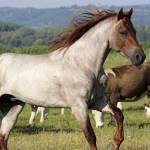Selenium Function in Horses

Selenium, an essential nutrient as well as an environmental toxicant, is best known as a component of the selenium-dependent enzyme glutathione peroxidase. As part of the cellular defense system, selenium, like vitamin E, functions much as a biological antioxidant, and indeed there are a number of deficiency symptoms of selenium that may be partially corrected by vitamin E and vice versa.
The antioxidant defense system allows for the trapping of free radicals and superoxides, which cause oxidative damage to lipid membranes. Simply put, glutathione peroxidase converts reduced glutathione to oxidized glutathione and destroys peroxides by changing them to harmless alcohols. This conversion of the peroxides prevents them from reacting with lipid membranes and causing loss of membrane integrity.
Exercise causes increased oxygen delivery to the tissues and oxidation of energy substrate resulting in the generation of reactive oxygen byproducts, peroxides. Therefore, athletic horses have an increased need for antioxidants including selenium. In a trial with sedentary geldings fed a basal diet, three levels of supplemental selenium (0.05, 0.1, and 0.2 ppm) were given to assess the impact of feeding supplemental selenium on plasma and whole blood selenium and on glutathione peroxidase, which has been thought to be an accurate indicator of selenium status. Results showed that there was a linear increase in plasma selenium over time until a level of 0.14 ppm was reached in the plasma, after which selenium reached a plateau regardless of the amount of selenium that was fed. There was no difference in peak plasma selenium values between 0.1 and 0.2 ppm supplemental selenium. Another trial did not show a relationship between dietary selenium level and glutathione peroxidase activity and suggested that plasma selenium might be a better indicator of selenium status. Whole blood selenium is higher than is plasma selenium, and this distinction should be made in the interpretation of blood test results.
There have been few studies dealing directly with the relationship of selenium requirements to exercise. In one study, researchers investigated the effect of supplemental selenium on plasma selenium and on glutathione peroxidase in Arabian and crossbred horses subjected to a conditioning program. Results showed that conditioning increased erythrocyte glutathione peroxidase activity and suggested that horses at high work intensities may have higher requirements for selenium than idle horses. Supplementing with selenium and vitamin E alleviates exertional rhabdomyolysis in some horses. These nutrients are thought to help by counteracting damage to muscle cell membranes and leakage of enzymes.
Selenium also appears to be part of the enzyme Type I iodothyronine deiodinase. This is a selenoenzyme which catalyzes the conversion of thyroxine (T4) to triiodothyronine (T3), which is the tissue active form of the thyroid hormone. It might be that some of the clinical manifestations of hypothyroidism are secondary to selenium deficiency.
Selenium and vitamin E can be supplemented by injection, but this practice is not recommended. Dietary selenium and vitamin E are well absorbed and result in increased plasma levels of these two nutrients, so oral supplementation is far safer for horses.








